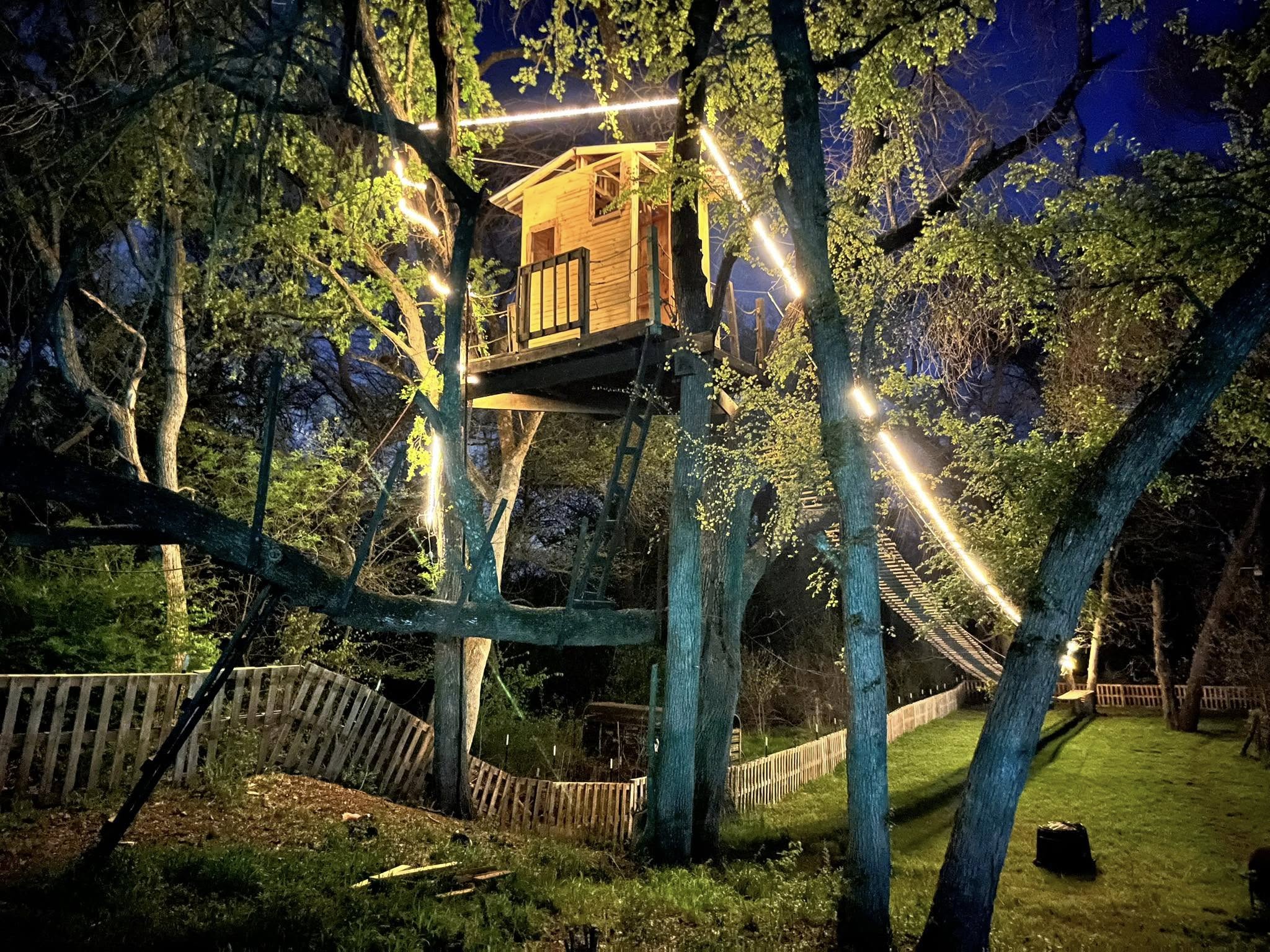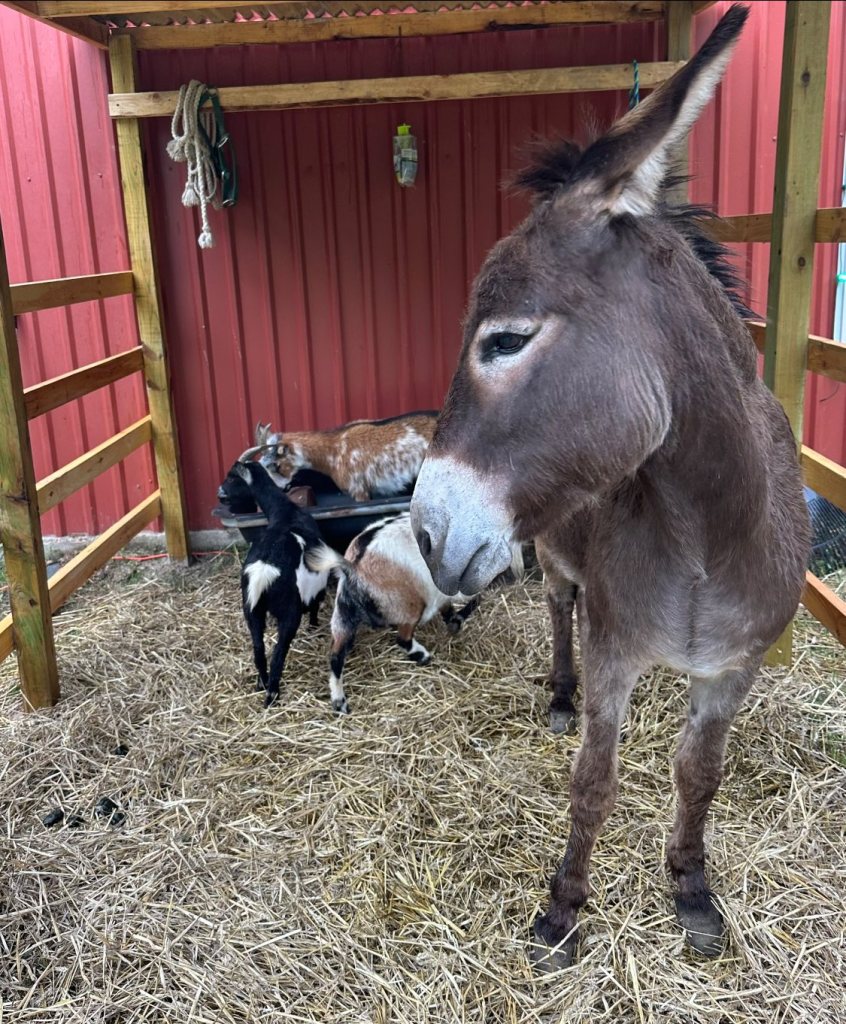
Courtesy of Clear Creek Adventure Ranch.

Audio By Carbonatix
The land along Clear Creek in Sanger holds generations of stories. It’s where Jeremy Sons’ great-grandfather John George arrived in a covered wagon in the 1920s, buying 50 acres of what was then raw country. It’s where his grandmother was raised and lived her entire life in the same house. For Jeremy and his wife, Katelyn, this land is more than just property. It’s a priceless inheritance of towering, hundred-year-old trees, a sanctuary for their family and home to the dozens of rescued animals at their Clear Creek Adventure Ranch.
Now, a new story is threatening to overwrite the old one — a story underlined in asphalt and concrete. The proposed Denton County Outer Loop, a 23-mile, six-lane tollway, has a route that cuts directly through the heart of this land, a critical wildlife corridor that Jeremy has spent his life exploring. For the Sons, this isn’t just a matter of “not in my backyard,” but a fight to protect one of the last vestiges of true rural country from being paved over.
“I’ve lived here my whole life,” Jeremy says, his voice a mixture of passion and frustration. “As a kid, you’re like, ‘Man, I gotta get out of here as soon as I can.’ But I just did not realize what a blessing it is living on the creek and having wildlife run through your yard.”
The proposed route, known as Alignment A, is the most expensive and environmentally disruptive of the options on the table. It slices through a dense flood zone along the creek, an area so thick with vegetation that it acts as a natural refuge for a stunning variety of animals.
This year, make your gift count –
Invest in local news that matters.
Our work is funded by readers like you who make voluntary gifts because they value our work and want to see it continue. Make a contribution today to help us reach our $30,000 goal!
“There are bald eagles right there. There are whooping cranes there every single year …” Jeremy says of the rare birds’ migration. He’s seen game camera footage of bobcats, foxes and river otters — secretive creatures that thrive in the seclusion of the creek bed.
“If you just back away on the map on your phone and look to see where all the green spots are … well, you put houses on all those green spots, there’s no more places for those animals to go,” he says.
The Outer Loop, he argues, wouldn’t just displace them; it would create an impassable wall, fragmenting their habitat and cutting them off from essential resources.
“You cut those green spots out and put highways through them, well, now they can’t freely move,” he says. “That is the end of them. There isn’t like, ‘well, they’ll just figure it out.’ No, there will be no figuring it out.”

Courtesy of Clear Creek Adventure Ranch
The frustration for the Sons family is compounded by what they see as a flawed and opaque planning process. At public meetings, they found themselves facing maps and informational posters, but few people who could offer real debate or answer substantive questions. The primary method for public input? Leaving a comment via voicemail or email.
“I said, ‘Is there a vote?’ No, no vote. But you can leave your comment,” Jeremy says. “So, the only thing that we are able as a public, as a citizen, to do [is] to leave a voicemail or an email. That was it.”
Even more alarming was their interaction with the environmental survey team. Over the course of a year-long study, the team assessed the ecological impact of the proposed route. Yet, Jeremy says that when he spoke with them, they were unaware of the resident bald eagles and the annual migration of whooping cranes.
“People are getting paid pretty good money to do a year’s survey, and then they don’t even know about those two things,” he says. A neighbor who lives across the street corroborated Jeremy’s account, telling the surveyors about the eagles that frequent his pond. It raised a critical question: If the official survey missed such prominent species, what else did it fail to see?
For Jeremy, the proposed path is not just an arbitrary line on a map. He sees it as a surgical strike against the most beautiful and vital part of the creek. The route is set to cross directly over the largest pristine sandy beach of the waterway, a spot where his family has found fossils.
“I’ve kayaked the whole creek, I mean like miles of it, and the best beach on the entire creek is right there,” he says, pointing toward the proposed crossing. “It’s the biggest roundabout beach that is just pure sand, and that’s exactly where they’re bringing it across.”
For Jeremy, the fight is deeply personal. It’s about preserving a legacy passed down from his great-grandfather, a farmer and rancher who instilled a deep connection to the land. It’s about the safety of the more than 60 rescued animals at their sanctuary, where one broken fence could mean a beloved creature wandering onto a high-speed tollway. But for the Sons, the battle extends beyond their own property line. It’s a stand for the wildlife that has no voice and for a way of life that is quickly vanishing.
“I always told everybody, I’m from the country. Sanger is the country,” Jeremy says. “And there ain’t much country left.”
The project planners present the Outer Loop as a necessary solution for a county projected to nearly double in population by 2050. For some who call this land home, it feels like a shortsighted solution that sacrifices the irreplaceable for convenience. The trees that stand 70 feet tall, the secret lives of bobcats and otters, the quiet tranquility of the creek — things that, once lost, no amount of money or progress can bring back.
As the bulldozers loom on the horizon, Jeremy and Katelyn are committed to being a voice for the land. They continue to attend meetings, spread the word and hold onto the hope that their 1% chance of making a difference can snowball into something powerful enough to change the course of the road.
“Our voice is our only weapon, [it’s] our only option,” Jeremy says. “And so, you take your 1% shot at making that difference, because you never know. One little grain of sand rolling down the hill can turn up into a big old ball weighing a million pounds. So, it all starts with that little, tiny dot.”
You can learn more detailed information about the Denton County Outer Loop project online. To discover more about Jeremy and Katelyn Sons, their work and their vision for conservation, visit Clear Creek Adventure Ranch’s website.